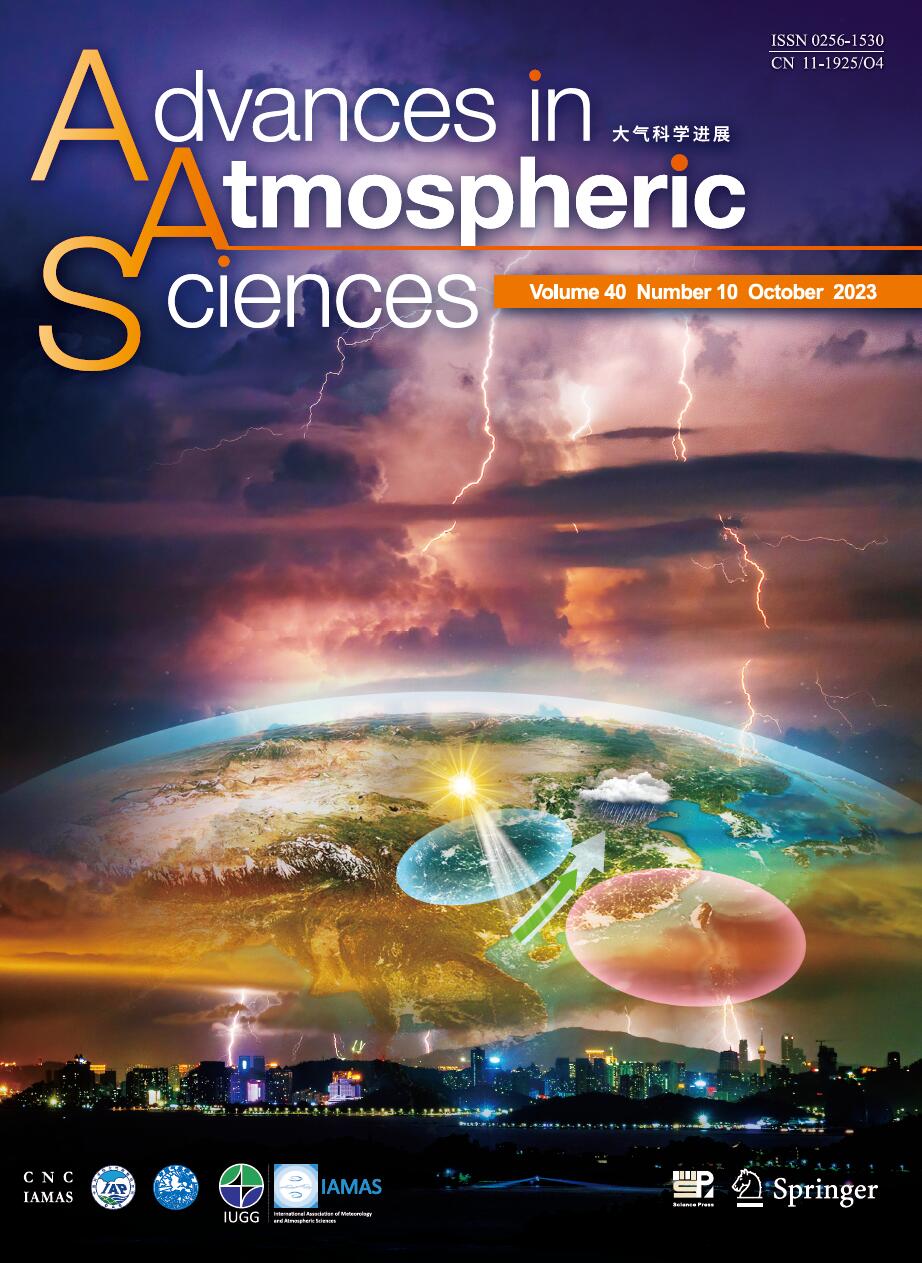| [1] |
CHEN Xiao, YAN Youfang, CHENG Xuhua, QI Yiquan,
2013: Performances of Seven Datasets in Presenting the Upper Ocean Heat Content in the South China Sea, ADVANCES IN ATMOSPHERIC SCIENCES, 30, 1331-1342.
doi: 10.1007/s00376-013-2132-1
|
| [2] |
LIU Xiangwen, WU Tongwen, YANG Song, LI Qiaoping, CHENG Yanjie, LIANG Xiaoyun, FANG Yongjie, JIE Weihua, NIE Suping,
2014: Relationships between Interannual and Intraseasonal Variations of the Asian-Western Pacific Summer Monsoon Hindcasted by BCC_CSM1.1(m), ADVANCES IN ATMOSPHERIC SCIENCES, 31, 1051-1064.
doi: 10.1007/s00376-014-3192-6
|
| [3] |
XUE Feng, ZENG Qingcun, HUANG Ronghui, LI Chongyin, LU Riyu, ZHOU Tianjun,
2015: Recent Advances in Monsoon Studies in China, ADVANCES IN ATMOSPHERIC SCIENCES, 32, 206-229.
doi: 10.1007/s00376-014-0015-8
|
| [4] |
He Youhai, Guan Cuihua, Gan Zijun,
1997: Interannual and Interdecadal Variations in Heat Content of the Upper Ocean of the South China Sea, ADVANCES IN ATMOSPHERIC SCIENCES, 14, 271-276.
doi: 10.1007/s00376-997-0025-x
|
| [5] |
YUAN Yuan, C. L. Johnny CHAN, ZHOU Wen, LI Chongyin,
2008: Decadal and Interannual Variability of the Indian Ocean Dipole, ADVANCES IN ATMOSPHERIC SCIENCES, 25, 856-866.
doi: 10.1007/s00376-008-0856-0
|
| [6] |
K.-M. Lau, Song Yang,
1997: Climatology and Interannual Variability of the Southeast Asian Summer Monsoon, ADVANCES IN ATMOSPHERIC SCIENCES, 14, 141-162.
doi: 10.1007/s00376-997-0016-y
|
| [7] |
Xue Feng, Zeng Qingcun,
1999: Diagnostic Study on Seasonality and Interannual Variability of Wind Field, ADVANCES IN ATMOSPHERIC SCIENCES, 16, 537-543.
doi: 10.1007/s00376-999-0029-9
|
| [8] |
Chen Wen, Hans-F. Graf, Huang Ronghui,
2000: The Interannual Variability of East Asian Winter Monsoon and Its Relation to the Summer Monsoon, ADVANCES IN ATMOSPHERIC SCIENCES, 17, 48-60.
doi: 10.1007/s00376-000-0042-5
|
| [9] |
LI Fei, WANG Huijun,
2012: Predictability of the East Asian Winter Monsoon Interannual Variability as Indicated by the DEMETER CGCMS, ADVANCES IN ATMOSPHERIC SCIENCES, 29, 441-454.
doi: 10.1007/s00376-011-1115-3
|
| [10] |
Hai ZHI, Rong-Hua ZHANG, Pengfei LIN, Peng YU,
2019: Interannual Salinity Variability in the Tropical Pacific in CMIP5 Simulations, ADVANCES IN ATMOSPHERIC SCIENCES, 36, 378-396.
doi: 10.1007/s00376-018-7309-1
|
| [11] |
Ji Liren, Sun Shuqing, Klaus Arpe, Lennart Benglsson,
1997: Model Study on the Interannual Variability of Asian Winter Monsoon and Its Influence, ADVANCES IN ATMOSPHERIC SCIENCES, 14, 1-22.
doi: 10.1007/s00376-997-0039-4
|
| [12] |
Wu Aiming, Ni Yunqi,
1997: The Influence of Tibetan Plateau on the Interannual Variability of Atmospheric Circulation over Tropical Pacific, ADVANCES IN ATMOSPHERIC SCIENCES, 14, 69-80.
doi: 10.1007/s00376-997-0045-6
|
| [13] |
HU Ruijin, LIU Qinyu, WANG Qi, J. Stuart GODFREY, MENG Xiangfeng,
2005: The Shallow Meridional Overturning Circulation in the Northern Indian Ocean and Its Interannual Variability, ADVANCES IN ATMOSPHERIC SCIENCES, 22, 220-229.
doi: 10.1007/BF02918511
|
| [14] |
YANG Junli, WANG Bin, GUO Yufu, WAN Hui, JI Zhongzhen,
2007: Comparison Between GAMIL, and CAM2 on Interannual Variability Simulation, ADVANCES IN ATMOSPHERIC SCIENCES, 24, 82-88.
doi: 10.1007/s00376-007-0082-1
|
| [15] |
WANG Jun, BAO Qing, Ning ZENG, LIU Yimin, WU Guoxiong, JI Duoying,
2013: Earth System Model FGOALS-s2: Coupling a Dynamic Global Vegetation and Terrestrial Carbon Model with the Physical Climate System Model, ADVANCES IN ATMOSPHERIC SCIENCES, 30, 1549-1559.
doi: 10.1007/s00376-013-2169-1
|
| [16] |
Ren Baohua, Huang Ronghui,
1999: Interannual Variability of the Convective Activities Associated with the East Asian Summer Monsoon Obtained from TBB Variability, ADVANCES IN ATMOSPHERIC SCIENCES, 16, 77-90.
doi: 10.1007/s00376-999-0005-4
|
| [17] |
WangHuijun, Xue Feng, Bi Xunqiang,
1997: The Interannual Variability and Predictability in a Global Climate Model, ADVANCES IN ATMOSPHERIC SCIENCES, 14, 554-562.
doi: 10.1007/s00376-997-0073-2
|
| [18] |
Li Wei, Yu Rucong, Zhang Xuehong,
2001: Impacts of Sea Surface Temperature in the Tropical Pacific on Interannual Variability of Madden-Julian Oscillation in Precipitation, ADVANCES IN ATMOSPHERIC SCIENCES, 18, 429-444.
doi: 10.1007/BF02919322
|
| [19] |
Hai ZHI, Rong-Hua ZHANG, Fei ZHENG, Pengfei LIN, Lanning WANG, Peng YU,
2016: Assessment of Interannual Sea Surface Salinity Variability and Its Effects on the Barrier Layer in the Equatorial Pacific Using BNU-ESM, ADVANCES IN ATMOSPHERIC SCIENCES, 33, 339-351.
doi: 10.1007/s00376-015-5163-y
|
| [20] |
Ya GAO, Huijun WANG, Dong CHEN,
2017: Interdecadal Variations of the South Asian Summer Monsoon Circulation Variability and the Associated Sea Surface Temperatures on Interannual Scales, ADVANCES IN ATMOSPHERIC SCIENCES, 34, 816-832.
doi: 10.1007/ s00376-017-6246-8
|















 AAS Website
AAS Website 
 AAS WeChat
AAS WeChat 
 DownLoad:
DownLoad: